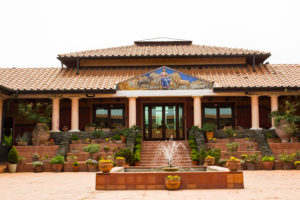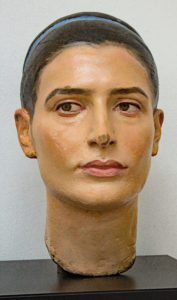Visiting the Roman ruins of “Viminacium”:http://viminacium.org.rs/en/, in eastern Serbia, requires your own transport as they’re situated around a 30-minute drive on narrow roads off the main E75, near the town of Kostolac. The 450-hectare site dates back to the 1st century and at its peak, was thought to have had 40,000 inhabitants. Much of the original city is adjacent to an open cast coal mine, or under arable cultivation and therefore still lies undiscovered.
Fortunately, or perhaps as planned, we arrived at 11.10am, just missing the hourly guided tour (in Serbian and English). It was busy with several large coaches parked and children milling around. Having disappeared into the Visitors’ Centre for some time, our guide, Miroslav, returned with dispensation to take us around himself. This was perfect as by this time, the groups had disappeared, and we had the covered mausoleum to ourselves. We later discovered Miroslav hated groups as much as us.
A large flip chart stand had pages which explained various elements: how the mausoleum would have been used, other Roman sites in the area and the names of the 18 Roman emperors etc. Having seen the site from a high walkway running around it, we went down steps to see it at eye level and the skeletons which had been discovered. We went underneath to see the vivid wall frescoes – this is not for the feint hearted as the passage is low, narrow and a little claustrophobic. The frescoes were in small alcoves which two people could just squeeze into. The paintings incorporated peacocks, which to the Romans, was a symbol of immortality because they believed peacock flesh didn’t decay after death. There was also paintings of a man and a woman. The floors were uneven and dusty, and we were pleased we had on good walking shoes.
We drove a few minutes to the Roman baths, again a covered area, but this time we could only view the ruins from a vantage point. Once again, information on a flip chart showed how the baths would have looked and explained how the water would have been heated by furnaces.
A new addition to the site, is the recreation of a wooden amphitheatre and another area (with gate and turrets) which was aimed at children, although our guide was scathing about this modern feature.
Next stop was a replica Roman Villa, amidst beautiful gardens, and again, we were allowed in on our own. We looked down onto on a model of how the site would have looked with its area of regimented rows of houses where the military would have lived and then the larger adjacent section, where the families lived along with the baths and amphitheatre. Steps took us down to see the model at eye level along with wall frescoes. Down a further flight, was an educational room with mosaic tiled floor and ceiling, and busts of the Roman emperors with the largest being that of Constantine. There was also a re-creation, using modern technology, of the head of the lady in the fresco we’d seen earlier.
There is accommodation here which Miroslav said is very peaceful and across the road, a larger dormitory block, built recently to host a group of visiting archaeologists. There was also another outdoor activity area for children.
On the site is a 1.5million year old skeleton of a woolly mammoth, only unearthed in June 2009, but time didn’t allow us to visit it. The Visitors Centre has a small café which apparently serves meals appropriate to the Roman time.










